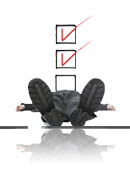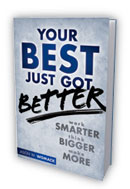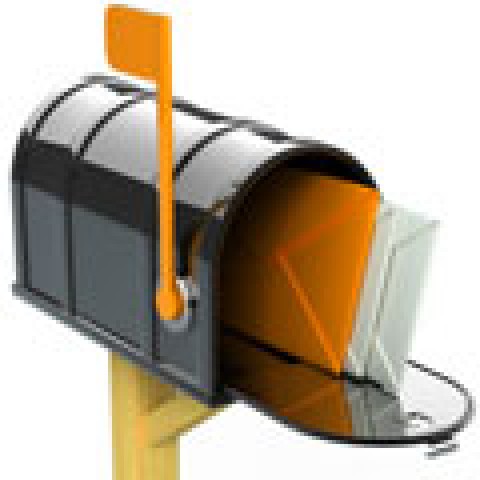 By Jason Womack
By Jason Womack
Do you dread it? You know … the feeling that the second you step foot in your office you’ll be hit with 20+ tasks to add to your to-do list (not to mention an inbox full of emails begging for an immediate response)?
Most of your dread doesn’t come from the work itself—it comes from how you think about the work.
The psychological weight of unfinished tasks and unmade decisions is huge. There is a constant feeling of pressure to do more with less. You can’t change that reality, but you can make peace with it.
How to Change
The first step to changing the way you get things done is to accept that you’re never going to get it all done. You’ll always be updating your to-do list by crossing off completed tasks and adding new ones … and that’s okay.
When you improve the way you approach the things you need to get done, both on the job and off, you’ll stop wishing things were different and start really making new things possible.
Here are 13 essential good habits for you to consider.
Block out your time and prioritize.
Ask yourself this: How much time do I really spend each day clicking through emails and making my to-do list? The answer is probably a lot.
When you spend your day making giant to-do lists or flagging “urgent” emails, you’ll never get any real work done. Instead look at your day and figure out where you have blocks of time to really focus and engage on what needs to be done.
Time blocking and prioritization are two important keys to daily productivity. Keep your defined ‘work’ actions to 15 to 30 minutes each. These are the ‘chunks’ of time you can use to stay focused, minimize interruptions, and work effectively.
Change how you manage email.
The moment you click on your inbox, your focus goes and your stress grows, as you proceed to delete, respond, forward, and file the messages you find there.
You see names and subject lines and suddenly your mind starts racing; all you can think of are the latest projects, the “loudest” issues, and the high-priority work that shows up. If you’re not careful, all you’ll do all day is manage your email.
Rather than simply flag emails that require action, use the subject lines to catalog and organize them. For example, you might put “Follow-up Call” in the subject line of an email about a meeting you just had with a client.
Also, don’t look at your email unless you have a block of time to devote to prioritizing them and responding to them. When you are going through your email, use subject lines to catalog them and organize them so that you’ll easily be able to go back to less urgent emails later on.
Take technology shortcuts.
I’ve written about a client who easily wasted over three hours a week organizing her emails into the 300+ folders she had down the left-hand column of her Microsoft Outlook.
And those three hours didn’t include the time she knew she’d have to spend catching up—putting most of her 7,000 inbox emails in those folders!
There are a few specific features (rules and search folders) in Microsoft Outlook that would enable her to cut down considerably the time she spent organizing her emails.
Practically every kind of software you use daily has tricks and shortcuts that once implemented could save you a lot of time. Sit down with those who can teach you more about these systems. The more you fully understand the tools you use, the easier it will be to learn even more about their features and how to use them to your advantage.
Break inertia.
Ever watch a freight train start to move? That first forward jolt takes the most energy; keeping the train rolling is much easier.
Do some small things to get rolling on getting caught up at the beginning of the day, then pace yourself. You’ll probably find it’s much easier to keep rolling along at a comfortable clip.
Keep your BlackBerry out of bed.
Another of my clients listed “Check e-mail on Blackberry (in bed)” as part of his daily morning routine. Note that he didn’t do anything about those emails while still in bed. He waited until he was commuting to work (he had a 40-minute train ride to the office each day) to start taking action. Then, he said, he rushed through his morning worrying about the emails he had read in bed.
Together, he and I designed a five-day experiment during which period he would leave his mobile device in another room and use an alarm clock to wake up instead of his phone. He would shower, dress, eat breakfast, and then check email on his train ride to work.
This change in his routine gave him a higher quality of life with less stress and increased productivity—one he didn’t know was possible without falling behind in his work.
Always be prepared for “bonus time.”
Bring small chunks of work with you wherever you go. Then, while waiting for a meeting to start or for a delayed flight to depart, you’ll be able to reply to an email or make a phone call.
In other instances, you might have enough time to review materials for another meeting or project you are working on. If you’re prepared, you can also confirm appointments, draft responses, or map out a project outline.
I can promise you that sometime during the next month, someone is going to arrive late for a meeting with you, cancel a meeting, or otherwise keep you waiting. When that inevitably happens, you can look over your to-do list and pick something—anything—to work on.
Reduce meeting time lengths.
If meetings at your organization are normally given a 60-minute time length, start giving them a 45-minute time length. You’ll find that what you get done in 60 minutes you can also achieve in 45 minutes. You’ll also gain 15 extra minutes for each meeting you have.
Usually, we fill the time we expect to fill. Give yourself less time, and you’ll get it done in less time. The shorter time frame really gets you focused. All that extra time will really add up and provide you with more time to work toward your goals.
Figure out what distracts you.
It can be extremely helpful to discern exactly what it is that gets in the way of your focus. Identify what is blocking your ability to give all of your attention to what needs your attention.
Is it the constant ding of emails popping up in your inbox? Is it employees or colleagues who need “just a minute” of your time? Once you have this inventory, you can begin to make subtle changes so that you wind up getting more done, in less time, at a higher level of quality.
I look for what I call the ‘big two’ when I’m coaching clients. Together, we uncover just two common interruptions or distractions that are getting in the way of their getting more important work done each day.
My goal is to minimize the kinds of distractions in my clients’ work world that can easily pull them away from doing the meaningful, important, prioritized work they need to get done.
Identify the VERBS that need attention. (And here’s a hint: smaller is better.)
Organize your to-do list by verbs in order to manage your productivity in terms of action, delegation, and progress.
Actions such as Call, Draft, Review, and Invite are things that you can do, generally in one sitting, that have the potential to move the project forward one step at a time.
If your to-do list has “big” verbs—by which I mean verbs that are mentally demanding or longer term in nature such as plan, discuss, create, or implement—replace them with action steps to just get started. That is, pick “smaller” verbs, by which I mean verbs describing tasks that are easier to start and faster to finish. This will save you time and reduce the sense of overload you’re feeling.
Learn to delegate clearly (much, much more clearly).
Come to terms with the fact that you can’t get it all done yourself. Identify exactly what needs to be done and by when. Over-communicate and (if you need to!) track what you have given to whom.
Check back weekly with your “Waiting on…” inventory and follow up with people who you think may wind up falling behind. Be relentless. After all, if the people you delegate to aren’t productive, you won’t be productive either.
Hold yourself accountable with end-of-day notecards.
At the end of each day (for 20 or so workdays) write down on a 3×5 notecard basic things about each day: Who you met with. What you completed. Where you went. What you learned.
At the end of the month, you can use this “inventory of engagement” to identify what you want/need to do more (or less!) of.
It is essential for you to be conscious of how much work there IS that you have taken on. When you see how much you ARE doing—or how little of the right things—you will be motivated to “get better.”
This activity is a great way to hold yourself accountable and make sure you’re really doing the things that help you make the most of your time.
Implement a weekly debrief.
Take time after every five-day period to stop, look around, and assess where you are in relation to where you thought you would be.
Look at three key areas: 1. What new ideas have emerged? 2. What decisions need to be made? 3. How do I track this information?
Not only does the weekly debrief help you hold yourself accountable, it allows you to course-correct if necessary. Things usually don’t go the way we expect them to, so these weekly debriefs give us the opportunity to ask ourselves, “Does this still make sense? And if not, what does?”
Forecast your future.
Open your calendar to 180 days from today. There, write three to four paragraphs describing what you’ll have done, where you’ll have been, and what will have happened to your personal/professional life by then.
This kind of “forecasting” is good to do from time to time, and by spending 10 or so minutes, especially at the beginning of the year thinking about the next six months, you’ll put your goals into action.
What we think about is what we do. Identifying what you’d like to experience is the first step in developing the habits and actions that move you closer to our goals. That ten minutes is the starting point in moving off the “thought trails” that force you into thinking what you’ve always thought—and doing what you’ve always done.
———-
Copyright 2012 Jason Womack.

To learn more about or to purchase his book, “Your Best Just Got Better,” please visit the PaperSpecs Book Corner.











